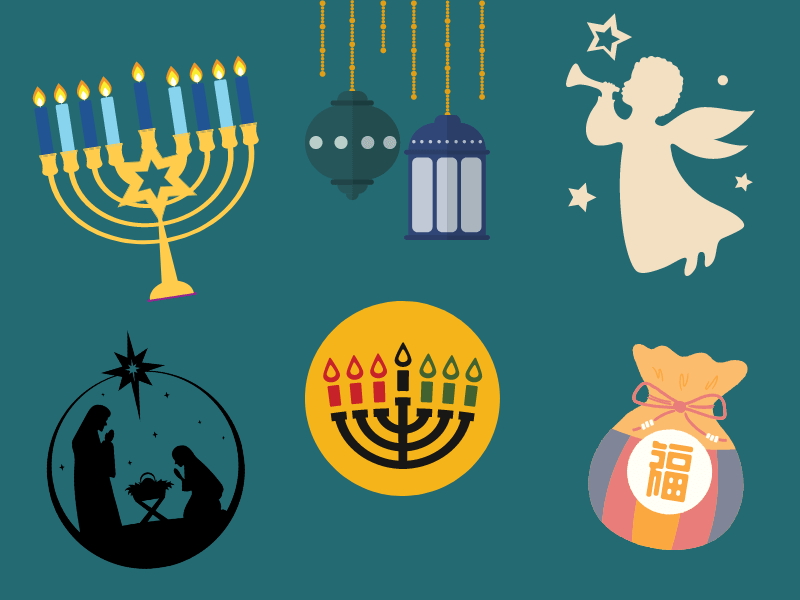As a holiday approaches, are you looking to celebrate with all-inclusive diversity at work? This guide offers actionable insights for those aiming to foster an inclusive holiday atmosphere at the workplace. Without favoring any single tradition, let’s navigate decorations, messaging, and events that make everyone feel valued during the festive season as well as celebrations throughout the year.
Key Takeaways
- Fostering an inclusive workplace environment during the year involves celebrating a diverse range of holidays and ensuring decorations and messages do not favor any single culture or belief.
- Inclusive language and neutral holiday greetings play a critical role in making employees from all backgrounds feel seen and respected, and should be thoughtfully crafted to convey warmth and togetherness.
- Sensitive considerations and support for those who may experience mixed emotions during the holidays are essential to accommodate the varied experiences and beliefs of all employees.
Celebrating Cultural Diversity During the Holiday Season

The holiday season is a time to celebrate the richness of cultural diversity, where “Happy Holidays” is a melody that harmonizes the joy of many celebrations. A workplace that embraces this diversity ensures that everyone feels included and valued. To celebrate diversity during different holidays, craft a collaborative holiday calendar where each festival shines—be it Hanukkah, Kwanzaa, or the Spring or Winter Solstice.
Prioritize your shared human community over the commercial rush of consumerism by focusing on the joy of connection and the spirit of giving that is the true essence of the season. By doing so, you create an environment where “Merry Christmas”, “Happy Hanukkah” and “Happy Kwanzaa” are part of a chorus of holiday greetings that resonate with unique holiday traditions.
Inclusive Decorations and Symbols
In a diplomatic workplace, decorations transcend individual cultural boundaries and become symbols of a collective celebration. For the winter holiday season, use cool blues, whites, and silvers, for a winter wonderland theme. A general seasonal theme welcomes all faiths and traditions and provides a visual representation of holiday cheer not confined to a specific holiday. The menorah and kinara stand side by side, illuminating shared spaces with the light of Hanukkah and the principles of Kwanzaa, while the ficus tree adorned with lights and beads whispers the story of Buddha’s enlightenment during Bodhi Day.
These symbols, along with neutral holiday cards depicting snowflakes and winter landscapes, celebrate the diversity of the winter holiday season without favoring anyone’s specific culture or religious beliefs.
Diverse Holiday Messaging in the Workplace

Crafting inclusive holiday messaging in the workplace is an art that respects individual preferences and embraces the full spectrum of winter holidays. It is about recognizing the many celebrations that occur during this time and ensuring that each person’s holiday traditions are acknowledged and valued.
Personalizing messages, whether they carry a professional or personal tone, reflects the organization’s commitment to honoring the diverse backgrounds of its employees. The aim is to create a visually equitable approach to holiday card-giving that resonates with everyone, from those who celebrate a particular holiday to those who observe the season in a more secular manner.
Guidelines for Company-wide Communications
When it comes to company-wide communications, understanding the cultural backgrounds of recipients is essential for sending holiday messages that are inclusive and personalized. Conducting optional and anonymous surveys to gather employees’ preferences allows organizations to tailor their communications in a manner that celebrates diversity without assuming participation in specific traditions.
Neutral expressions like “Season’s Greetings” and messages that emphasize collective achievement resonate with a diverse workforce, ensuring that end-of-year communications reflect the diverse spirit of the organization.
Planning Inclusive Workplace Events
All-embracing workplace events are a manifestation of an organization’s commitment to celebrating its diverse workforce. By involving employees from different backgrounds in the planning process, you ensure that your holiday event authentically represents the multitude of cultures within your organization. Also focus on accessibility and comfort, to create an environment where everyone can participate fully, regardless of their abilities or personal preferences.
Shifting to Team and Work-Centered Days
Celebrating your team’s achievements during special times and events is a great way to increase employee engagement and therefore improve employee retention. Celebrations about the team itself can shift the focus from individual cultural or religious observances to a shared sense of success and pride in collective work.
As an HR professional, it’s important to recognize and appreciate the hard work and dedication of your employees. Celebrating work-centered holidays such as Administrative Professionals Day in April, Labor Day in September, and Bosses Day in October are great ways to boost employee morale and show your appreciation at different times of the. You can add company-specific days to the calendar that are unique to your business as well. These highlight and celebrate events that are inclusive for all employees.
On an individual level, you can note each employee’s hire date and send them a special message every year to show employee appreciation. For significant company milestones, such as business anniversary milestone years, you can plan unique events that involve your employees or welcome the local community for a broader celebration.
Diverse Holiday Language: Beyond “Merry Christmas” and “Happy Easter”
Embracing equitable language in holiday greetings is essential for ensuring that every member of your diverse workforce feels seen and respected. Phrases like “Happy Holidays”, “Season’s Greetings” and “Happy Spring” extend warm wishes to all, regardless of the specific holiday observed. It’s about selecting words that resonate with everyone, embracing the full range of seasonal holidays and cultural celebrations without focusing on a single tradition.
However, it’s also important to be sensitive to times of solemnity or reflection, recognizing that “Happy Holidays” may not always be the most appropriate politically correct holiday greeting.
Neutral Phrases for Warm Wishes
Neutral phrases for holiday wishes are the key to conveying warmth and inclusivity. A greeting such as “Wishing you peace & contentment” or “May joy, love, and laughter fill your home” can be embraced by people of all traditions. These phrases, along with others like “Warmest thoughts and best wishes for a wonderful holiday,” are crafted to be embracing of all celebrations, ensuring that no one is left out during the festive season.
Emphasizing Joy and Togetherness
Messages that emphasize joy and togetherness hold universal appeal and resonate with diverse audiences. By focusing on values such as love, warmth, and happiness, holiday greetings can acknowledge a variety of winter holiday traditions, including the happy winter solstice.
Crafting a considerate holiday message that conveys warmth and well-wishes, carefully tailored for the occasion and mindful of the recipient’s cultural and religious beliefs, is a way to reinforce interpersonal relationships and the bonds that unite us as colleagues and friends.
The Joy of Multicultural Holiday Celebrations

Multicultural holiday celebrations are a joyous opportunity to learn about and enjoy the vast array of global festivities. By celebrating different cultures through holidays, such as Diwali, Bodhi Day, and the Winter Solstice, you can expose the workplace to new traditions and stories.
These celebrations provide a fun and educational experience, fostering employee appreciation and education for the diverse world we live in and enhancing collective holiday cheer.
Hosting Diversified Holiday Gatherings

Holiday gatherings are a celebration of a community’s cultural richness. Displaying a wide range of holiday symbols, from menorahs to kinara candles, reflects the diversity of the celebrations among us. By organizing a holiday potluck where employees bring dishes from their own traditions, you can create a space for cultural appreciation and open dialogue.
Providing an inclusive menu and accommodating different dietary preferences ensures that everyone is included and can partake in the joy of the season.
Incorporating Multilingual Greetings
Incorporating multilingual greetings into holiday celebrations is an expression of respect and appreciation for the diversity of cultures and languages within a global community. Whether it’s “Feliz Navidad,” “Buon Natale,” or “Frohes Chanukka,” using greetings in different languages shows that you value and acknowledge the varied holiday traditions and practices observed by colleagues around the world.
Sensitive Considerations During the Holidays
The holiday season can be a time of mixed emotions for many, with some experiencing stress, sadness, or loneliness. It’s important to be sensitive to these diverse experiences, offering support and understanding to those who may not be feeling the holiday cheer.
Providing diverse holiday greetings and being mindful of those facing less than cheerful circumstances is an act of compassion and consideration.
Acknowledging Different Experiences
Acknowledging that individuals celebrate holidays differently due to their diverse religions, traditions, and personal beliefs contributes to a more inclusive festive environment. Choosing warm, considerate greetings and being sensitive to others’ circumstances can help create a friendly and festive atmosphere for all.
Supporting Those Who Don’t Celebrate
For those who don’t celebrate specific holidays, wishing them a “restful start to the new year” is a way to express goodwill respectfully. Implementing inclusive holiday leave policies allows employees to take time off for celebrations relevant to them, accommodating a diverse range of observances. Also celebrating company-specific special days such as Administrative Professionals Day and employee anniversaries, can still ensure that everyone is celebrated and included.
Summary
To wrap up the exploration of inclusive holiday celebrations in the workplace, we are reminded of the power of embracing diversity. From the decorations that adorn your spaces to the messages you share, every aspect of your celebration can reflect the richness of the world’s many cultures and traditions. Let’s carry the spirit of these inclusive practices forward, creating a warm and flexible workplace environment that not only respects but also exults in the beautiful diversity of its people. Let this holiday season be a time when every voice is heard, every tradition is honored, and every colleague feels the warmth of genuine holiday cheer.
Frequently Asked Questions
What does it mean to celebrate diversity?
Celebrating diversity means recognizing and honoring a wide range of cultural, social, and personal differences, and finding common ground rather than division. It involves embracing and appreciating what makes each person or group unique and special.
Is it OK to say happy holidays to Jehovah Witness?
It is not recommended to say “happy holidays” to Jehovah’s Witnesses as they do not celebrate any holidays. Sending a generic greeting like “Happy Holidays” may be more appropriate in a business context.
Is it more inclusive to say happy holidays?
Yes, saying “Happy Holidays” is more inclusive because it encompasses a wider range of celebrations and acknowledges the diversity of traditions and holidays celebrated. Regardless of religious affiliation, people can still enjoy the festive season for its cultural and joyful aspects.
How do you appreciate diversity during the holidays?
You can appreciate diversity during the holidays by taking time to learn about other cultures’ celebrations, such as watching TV specials, doing online research, or exploring books and ideas related to different holidays. Embracing diversity can enrich your holiday experience and promote understanding of other cultures.
What are some examples of inclusive holiday decorations?
Inclusive holiday decorations can include secular themes like a winter wonderland and symbols from various traditions such as menorahs for a happy Hanukkah, kinara candles for a joyous Kwanzaa, and ficus trees for Bodhi Day. These decorations aim to show inclusion and represent diverse cultural celebrations during the holiday season.


